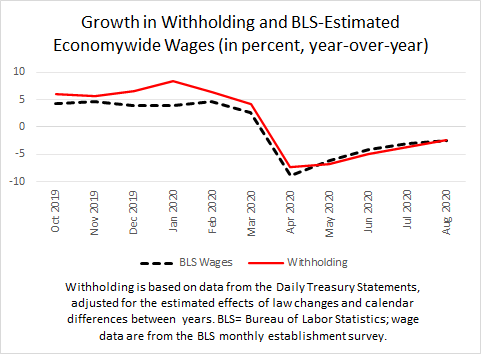Posted on September 5, 2020
Here are two paragraphs and two exhibits about yesterday’s release by the Bureau of Labor Statistics (BLS) of its monthly labor market report for August. The headline was the continued improvement in employment in August, as about half of the total drop in employment at the worst of the downturn in April has been regained. BLS also reported on the status of economywide wages, which incorporate not only employment changes but also changes in hourly earnings and hours worked per week; that measure shows that overall wage growth in the economy, after having dropped very sharply in April (by 8.9 percent compared to April 2019), is also about halfway back to pre-pandemic amounts (see chart below). The change in wages in August (down by 2.5 percent compared to August 2019) also lines up closely with the monthly decline of 2.4 percent we had estimated at the end of August for economywide income and payroll tax withholding (adjusted for the estimated effects of law changes enacted in March).

The decline and partial recovery in the BLS measure of wages mainly reflects movements in employment, but changes in average hourly earnings and weekly hours worked have also contributed (see table below). In April, total private-sector employment was down by over 15 percent compared to the amount in April 2019, but the year-over-year decline has been cut by about half, to a 7.4 percent decline in August: even removing the year-over-year measurement, about half of the total jobs lost in April have been recouped. Increases in average hourly earnings are actually running higher (4.7 percent gain) in August compared to pre-pandemic amounts (3.0 percent in February), presumably due to the mix effect of a disproportionate amount of the employment loss being for lower-wage earners; thus, that is not a true improvement given that it could occur even if no individual worker experienced faster growth in their average hourly wage rate. So, the bottom line is that employment, the main cause of the recent drop in total wages, has improved in recent months but still has a long way to go to get back to pre-pandemic levels.
